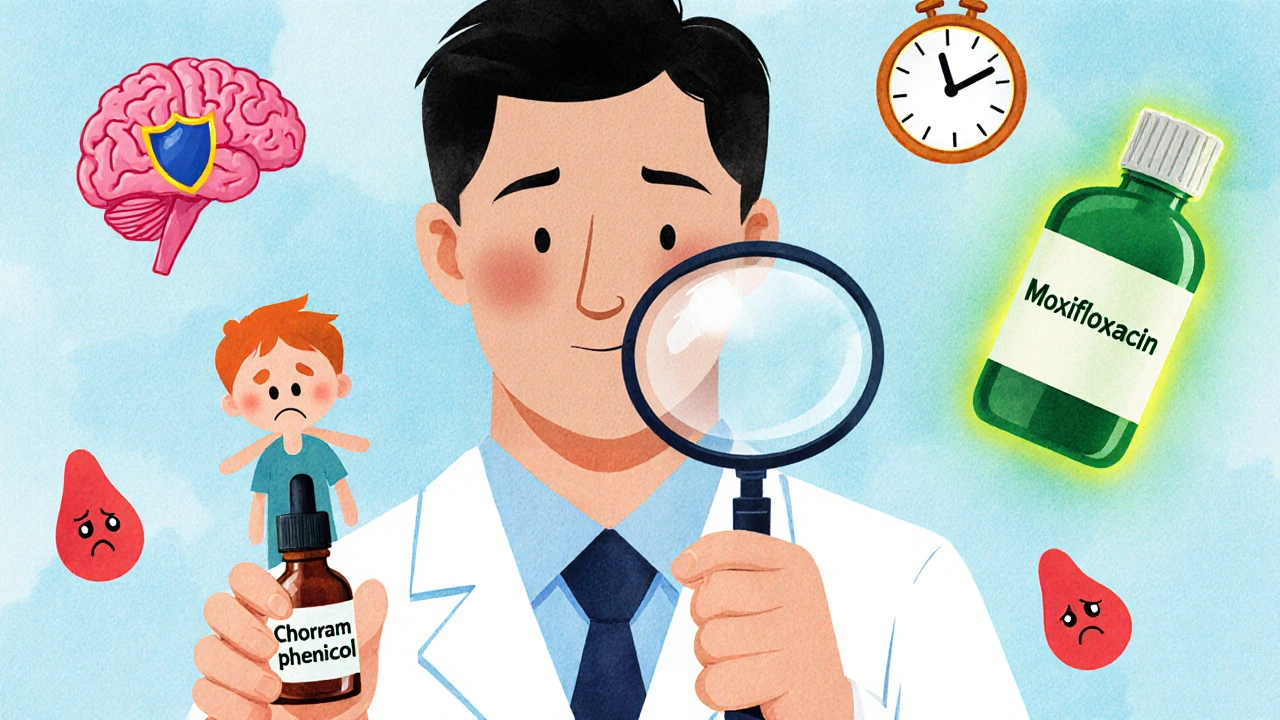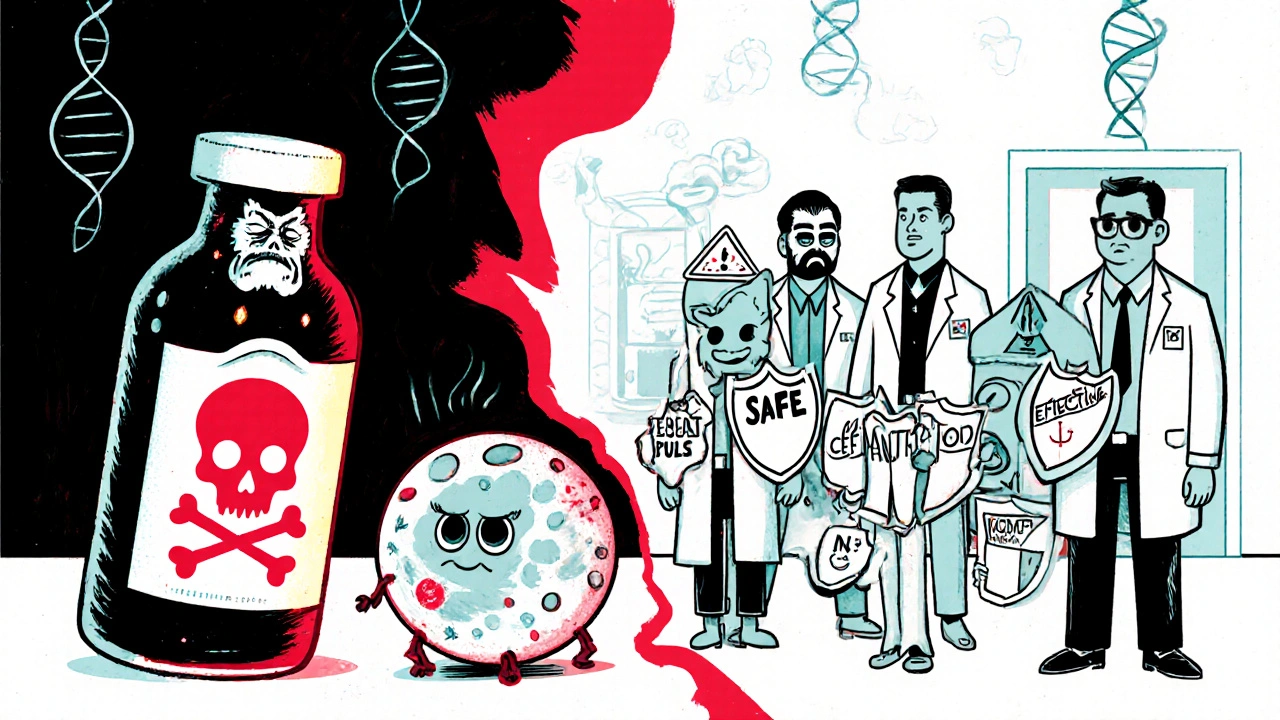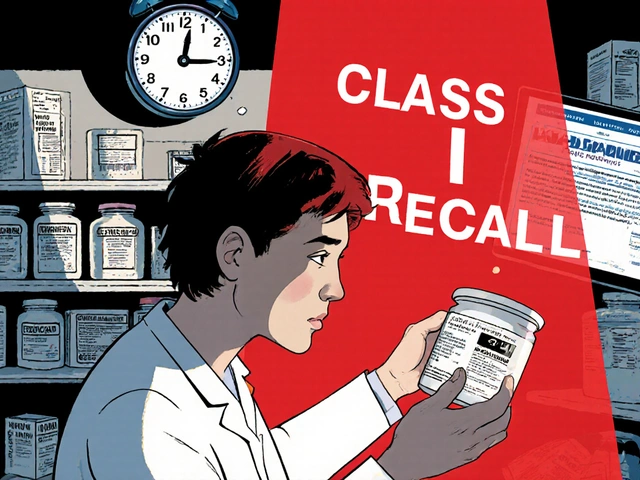Chloramphenicol is one of the oldest antibiotics still in use today - but it’s not the first choice for most infections anymore. Developed in the 1940s, it was once a miracle drug for deadly diseases like typhoid fever and bacterial meningitis. Today, it’s reserved for rare, serious infections because of its dangerous side effects. If you’ve been prescribed chloramphenicol, you’re probably wondering: are there safer, equally effective options? The answer isn’t simple. Some infections still need chloramphenicol. Others can be treated with antibiotics that don’t risk your bone marrow or vision.
What chloramphenicol actually does
Chloramphenicol is a broad-spectrum antibiotic, meaning it attacks a wide range of bacteria - both Gram-positive and Gram-negative. It works by stopping bacteria from making proteins, which they need to survive and multiply. This makes it effective against stubborn infections like bacterial meningitis, typhoid fever, and eye infections caused by resistant strains.
But here’s the catch: chloramphenicol doesn’t just target bad bacteria. It can also shut down protein production in your own bone marrow cells. That’s why it carries a black box warning from the FDA - the strongest possible alert. In rare cases, it can cause aplastic anemia, a life-threatening condition where your body stops making red blood cells, white blood cells, and platelets. The risk is low - about 1 in 25,000 - but it’s permanent and often fatal.
There’s also a less dangerous but more common issue: reversible bone marrow suppression. This can cause fatigue, easy bruising, or frequent infections. It usually goes away when you stop taking the drug, but it still means regular blood tests are required while you’re on chloramphenicol.
When chloramphenicol is still the best option
You might be surprised to learn that chloramphenicol is still used - and even preferred - in certain situations. In low-resource countries, it’s often the go-to for bacterial meningitis because it’s cheap, stable without refrigeration, and crosses the blood-brain barrier well. In the U.S. and Europe, it’s reserved for cases where other antibiotics have failed or aren’t suitable.
Examples include:
- Eye infections caused by bacteria resistant to standard drops
- Brain abscesses when the pathogen is unknown and broad coverage is needed
- Rocky Mountain spotted fever in patients allergic to doxycycline
- Cholera in areas with limited access to other drugs
In these cases, doctors weigh the risk of side effects against the risk of death from the infection. For someone with a life-threatening brain infection and no other options, chloramphenicol can be the only choice.
Top alternatives to chloramphenicol
For most common infections, there are safer, better-studied alternatives. Here’s how the most common ones compare:
| Antibiotic | Best For | Common Side Effects | Black Box Warning? | Cost (U.S. 2025) |
|---|---|---|---|---|
| Chloramphenicol | Severe meningitis, resistant eye infections, typhoid | Bone marrow suppression, gray baby syndrome, nausea | Yes | $10-$50 (oral); $20-$80 (IV) |
| Amoxicillin-Clavulanate | Sinusitis, ear infections, skin infections | Diarrhea, rash, upset stomach | No | $15-$40 |
| Ceftriaxone | Meningitis, gonorrhea, severe pneumonia | Injection site pain, diarrhea, mild allergic reactions | No | $50-$150 (IV/IM) |
| Doxycycline | Rocky Mountain spotted fever, Lyme disease, acne | Sun sensitivity, upset stomach, tooth discoloration in kids | No | $5-$20 |
| Moxifloxacin | Respiratory infections, intra-abdominal infections | Nausea, dizziness, rare tendon rupture | Yes (tendon rupture risk) | $70-$120 |
Amoxicillin-clavulanate is the most common replacement for mild to moderate infections. It’s safe for kids, pregnant women, and older adults. Ceftriaxone, given as an injection, is the standard for bacterial meningitis in hospitals - and it doesn’t touch your bone marrow. Doxycycline is preferred for tick-borne diseases like Lyme or Rocky Mountain spotted fever, where chloramphenicol used to be used.
Moxifloxacin is a powerful option for lung or abdominal infections, but it’s not first-line because of tendon risks and rising resistance. It’s also more expensive.

Why doctors avoid chloramphenicol unless they have to
Most doctors haven’t prescribed chloramphenicol in years. In the U.S., it’s not even available as an oral tablet for general use - only as eye drops or IV injections in hospitals. Even then, it’s only used after other drugs fail.
One reason is the rise of better alternatives. Ceftriaxone replaced chloramphenicol for meningitis in the 1990s. Azithromycin and doxycycline took over for respiratory and tick-borne infections. The few remaining uses are niche: drug-resistant eye infections in elderly patients, or rare bacterial strains in tropical regions.
There’s also a legal and liability factor. If a patient develops aplastic anemia after taking chloramphenicol, the doctor could face serious consequences - even if the risk was low. That’s why many avoid it entirely unless there’s no other option.
What you should do if you’re prescribed chloramphenicol
If your doctor prescribes chloramphenicol, don’t panic - but do ask questions. Here’s what to ask:
- Why is this the best option for me? Is there a safer alternative?
- What’s the exact infection I have? Is it confirmed by lab tests?
- Will I need blood tests during treatment? How often?
- What symptoms should I watch for - like unexplained bruising, fatigue, or fever?
- Is this a short-term course? How many days?
If your infection is mild - like a sinus infection or ear infection - chloramphenicol is almost certainly not needed. Ask if amoxicillin, cefdinir, or even a wait-and-see approach might work.
For eye infections, chloramphenicol drops are still commonly used because the systemic risk is minimal. But even then, newer drops like moxifloxacin or gatifloxacin are often preferred because they’re just as effective and don’t carry any systemic risks.

What happens if you take chloramphenicol and don’t need it
Taking chloramphenicol when it’s not necessary is risky and pointless. It doesn’t work against viruses - so if you have a cold, flu, or most sore throats, it won’t help. But it can still harm your bone marrow.
Worse, it contributes to antibiotic resistance. Bacteria that survive chloramphenicol exposure can pass on resistance genes. That means future infections - even ones treated with other antibiotics - might become harder to treat.
There’s also the risk of gray baby syndrome in newborns. This rare but deadly reaction happens because babies can’t break down chloramphenicol properly. It builds up in their blood and causes low blood pressure, breathing problems, and death if not caught early. That’s why it’s never used in newborns unless it’s a last-resort case in a neonatal ICU.
Bottom line: chloramphenicol is a last-resort drug
Chloramphenicol isn’t obsolete - but it’s not a first-line treatment anymore. For 95% of infections, safer, more predictable antibiotics are available. If you’re prescribed chloramphenicol, make sure it’s truly necessary. Ask for lab results. Ask about alternatives. Ask about monitoring.
It’s not about avoiding all antibiotics. It’s about using the right one for the right reason. Chloramphenicol saves lives - but only when no other option exists. For everything else, modern medicine has better tools.
Is chloramphenicol still used today?
Yes, but only in specific cases: severe eye infections, drug-resistant meningitis, typhoid in resource-limited areas, or when other antibiotics fail. It’s rarely used in routine care due to its risks.
Can chloramphenicol cause permanent damage?
Yes. In about 1 in 25,000 cases, it can cause aplastic anemia - a rare but often fatal condition where the bone marrow stops producing blood cells. This damage is permanent and not reversible, even after stopping the drug.
Is chloramphenicol safe for children?
Not generally. Newborns and infants are at high risk for gray baby syndrome, a life-threatening condition caused by the drug building up in their system. It’s only used in neonates in extreme cases under strict hospital monitoring.
What’s the safest antibiotic for a sinus infection?
Amoxicillin-clavulanate is the most common and safest first choice. For people allergic to penicillin, doxycycline or azithromycin are good alternatives. Chloramphenicol is never recommended for routine sinus infections.
Why isn’t chloramphenicol available as a pill in the U.S.?
Because of the risk of fatal bone marrow suppression, the FDA restricted oral chloramphenicol to hospital use only. It’s still available as eye drops and IV injections, where the dose is controlled and monitored.
Can I take chloramphenicol if I’m pregnant?
No. Chloramphenicol crosses the placenta and can harm the unborn baby’s bone marrow. It’s classified as Pregnancy Category D - meaning there’s clear evidence of risk. Safer alternatives like amoxicillin or ceftriaxone are used instead.



Andrew Baggley on 20 November 2025, AT 14:09 PM
Chloramphenicol is basically the antibiotic version of a chainsaw when you just need a screwdriver. I get why it exists - it’s like that one uncle who still uses a flip phone because he swears it’s ‘more reliable.’ But if your doctor’s reaching for it for a sinus infection, run. Amoxicillin-clavulanate is cheaper, safer, and doesn’t make you question whether your blood is gonna stop working tomorrow. 🙃